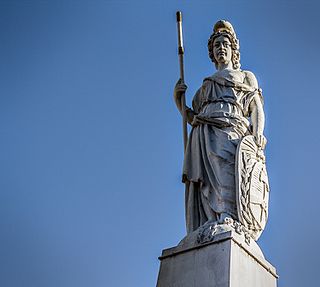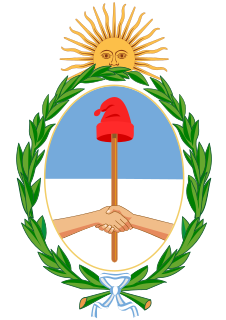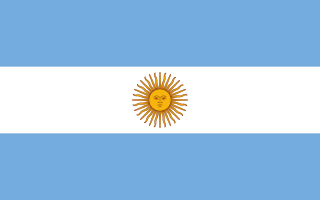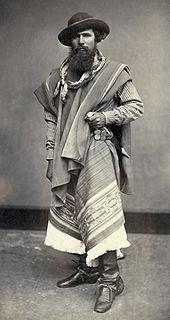 W
WArgentina has a number of national symbols, some of which are extensively defined by law.
 W
WThere are various allegorical representations of Argentina or associated in any way with Argentina. There is not, however, a national personification with its own name, like Marianne from France, or Hispania from Spain, but sculptures and engravings representing liberty, republic, fatherland or other concepts that have been used officially by the Argentine state.
 W
WThe Andean condor is a South American bird in the New World vulture family Cathartidae and is the only member of the genus Vultur. Found in the Andes mountains and adjacent Pacific coasts of western South America, the Andean condor is the largest flying bird in the world by combined measurement of weight and wingspan. It has a maximum wingspan of 3.3 m and weight of 15 kg (33 lb). It is generally considered as the largest bird of prey in the world.
 W
WThe "Argentine National Anthem" ; is the national anthem of Argentina. Its lyrics were written by the Buenos Aires-born politician Vicente López y Planes and the music was composed by the Spanish musician Blas Parera. The work was adopted as the sole official song on May 11, 1813, three years after the May Revolution; May 11 is therefore now Anthem Day in Argentina.
 W
WAsado is the technique and the social event of having or attending a barbecue in various South American countries, especially Argentina, Chile and Uruguay where it is also a traditional event. An asado usually consists of beef, pork, chicken, chorizo, and morcilla which are cooked on a grill, called a parrilla, or an open fire. Generally the meats are accompanied by red wine and salads. This meat is prepared by a person who is the assigned asador or parrillero.
 W
WThe coat of arms of the Argentine Republic or Argentine shield was established in its current form in 1944, but has its origins in the seal of the General Constituent Assembly of 1813. It is supposed that it was chosen quickly because of the existence of a decree signed on February 22 sealed with the symbol. The first mention of it in a public document dates to March 12 of that same year, in which it is stated that the seal had to be used by the executive power, that is, the second triumvirate. On April 13 the National Assembly coined the new silver and gold coins, each with the seal of the assembly on the reverse, and on April 27 the coat of arms became a national emblem. Although the coat of arms is not currently shown on flags, the Buenos Aires-born military leader Manuel Belgrano ordered to paint it over the flag he gave to the city of San Salvador de Jujuy, and during the Argentine War of Independence most flags had the coat of arms.
 W
WThe Argentine cockade is one of the national symbols of Argentina, instituted by decree on February 18, 1812 by the First Triumvirate, who determined that "the national cockade of the United Provinces of the Río de la Plata shall be of colours white and light blue [...]".
 W
WEn unión y libertad is Argentina's national motto. It appeared for the first time on the earliest Argentine gold and silver coins, as established by the 1813 General Assembly during the War of Independence of the United Provinces of the Río de la Plata from the Spanish Empire. The motto is considered to be a reference to the ideals of French Revolution.
 W
WErythrina crista-galli, often known as the cockspur coral tree, is a flowering tree in the family Fabaceae, native to Argentina, Uruguay, southern Brazil and Paraguay. It is widely planted as a street or garden tree in other countries, notably in California. It is known by several common names within South America: ceibo, seíbo (Spanish), corticeira (Portuguese) and the more ambiguous bucaré, to name a few. Its specific epithet crista-galli means "cock's comb" in Latin.
 W
WThe flag of Argentina is a triband, composed of three equally wide horizontal bands coloured light blue and white. There are multiple interpretations on the reasons for those colors. The flag was created by Manuel Belgrano, in line with the creation of the Cockade of Argentina, and was first raised at the city of Rosario on February 27, 1812, during the Argentine War of Independence. The National Flag Memorial was later built on the site. The First Triumvirate did not approve the use of the flag, but the Asamblea del Año XIII allowed the use of the flag as a war flag. It was the Congress of Tucumán which finally designated it as the national flag, in 1816. A yellow Sun of May was added to the center in 1818.
 W
WA gaucho or gaúcho is a skilled horseman, reputed to be brave and unruly. The figure of the gaucho is a folk symbol of Argentina, Uruguay, Rio Grande do Sul in Brazil, and the south of Chilean Patagonia. Gauchos became greatly admired and renowned in legend, folklore, and literature and became an important part of their regional cultural tradition. Beginning late in the 19th century, after the heyday of the gauchos, they were celebrated by South American writers.
 W
WLocro is a hearty thick squash stew, associated with Native Andean civilizations, and popular along the Andes mountain range. It's one of the national dishes of Peru, Bolivia, Ecuador, Chile, Paraguay and Northwest Argentina.
 W
WThe logo of Argentina refers to the official logo of the Marca País (MP), a State policy of nation branding that aims to promote tourism, boost exports, attract investments and spread Argentine culture.
 W
WOur Lady of Luján is a celebrated 16th-century statue of the Virgin Mary, mother of Jesus Christ. The image, also known as the Virgin of Luján, is on display in the Basilica of Luján in Argentina. The feast day of Our Lady of Luján is May 8.
 W
WArgentina is the fifth largest producer of wine in the world. Argentine wine, as with some aspects of Argentine cuisine, has its roots in Spain. During the Spanish colonization of the Americas, vine cuttings were brought to Santiago del Estero in 1557, and the cultivation of the grape and wine production stretched first to neighboring regions, and then to other parts of the country.
 W
WOur Lady of Itatí, also known as the Virgin of Itatí, is a Roman Catholic title of the Virgin Mary, whose principal shrine is in the city of Itatí, Corrientes Province, Argentina. Her feast day is celebrated on July 9, with an anniversary celebration on July 16.
 W
WPato, also called juego del pato, is a game played on horseback that combines elements from polo and basketball. It is the national sport of Argentina since 1953.
 W
WThe Phrygian cap or liberty cap is a soft conical cap with the apex bent over, associated in antiquity with several peoples in Eastern Europe and Anatolia, including the Balkans, Dacia, Thrace and Phrygia, where the name originated.
 W
WRhodochrosite is a manganese carbonate mineral with chemical composition MnCO3. In its (rare) pure form, it is typically a rose-red color, but impure specimens can be shades of pink to pale brown. It streaks white, and its Mohs hardness varies between 3.5 and 4. Its specific gravity is between 3.5 and 3.7. It crystallizes in the trigonal system, and cleaves with rhombohedral carbonate cleavage in three directions. Crystal twinning often is present. It is transparent to translucent with refractive indices of nω=1.814 to 1.816, nε=1.596 to 1.598. It is often confused with the manganese silicate, rhodonite, but is distinctly softer. It is officially listed as one of the National symbols of Argentina.
 W
WThe rufous hornero is a medium-sized ovenbird in the family Furnariidae. It occurs in eastern South America, and is the national bird of Argentina and Uruguay. Also known as the red ovenbird, it is common in savannas, second-growth scrub, pastures and agricultural land and is synanthropic. Its range includes midwestern, southeastern and southern Brazil, Bolivia, Paraguay, Uruguay and northern and central Argentina, extending as far south as northern Patagonia. The species is most closely related to the crested hornero of Paraguay and Argentina. There are four accepted subspecies.
 W
WJosé Francisco de San Martín y Matorras, known simply as José de San Martín or the Liberator of Argentina, Chile and Peru, was an Argentine general and the primary leader of the southern and central parts of South America's successful struggle for independence from the Spanish Empire who served as the Protector of Peru. Born in Yapeyú, Corrientes, in modern-day Argentina, he left the Viceroyalty of the Río de la Plata at the early age of seven to study in Málaga, Spain.
 W
WSchinopsis balansae is a hardwood tree known as willow-leaf red quebracho which forms forests in the subtropical Gran Chaco ecoregion of north-eastern Argentina, and Paraguay. It is also found in the wild Pantanal vegetation in Brazil. Some of its vernacular names are quebracho colorado chaqueño and quebracho santafesino. Other species, like Schinopsis lorentzii, bear the general name quebracho and have similar properties and uses. S. balansae shares its habitat with a species of the same genus, S. heterophylla, and the two are often confused.
 W
WThe Sun of May is a national emblem of Argentina and Uruguay, and appears on the flags of both countries.